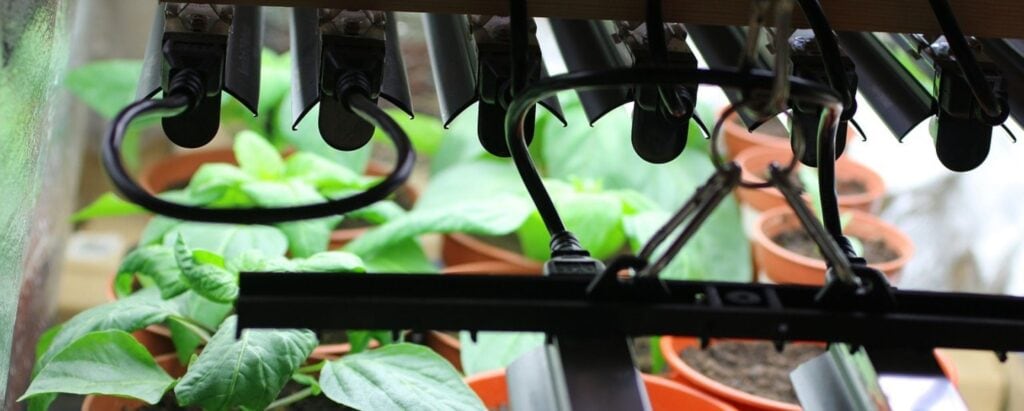Disclosure: This post may contain affiliate links. If you click on a link I may make a small commission at no extra cost to you. You can read the full disclosure here.
Last Updated on October 23, 2022 by Chris Panteli
Microgreens Lighting
Starting your own microgreen garden means figuring out which lights for microgreens are best.
Choosing the wrong types of light could mean your microgreens won’t grow or they might suffer catastrophic damage to fresh plant tissue.
The good news is that microgreens lighting has plenty of suitable options for all budgets. Learning more about these grow lights will mean you can enjoy greater microgreen growth!
As an indoor gardener, the higher your confidence level is the easier it will be to grow your microgreens and create a wonderful indoor garden.
What lighting is best for microgreens?
Natural sunlight is the best for growing microgreens. LED lights and fluorescent lighting are fantastic choices when you need to use artificial light.
- Microgreens Lighting
- Natural Light Versus Artificial Lighting for Microgreens
- What Lights to Use for Growing Microgreens Indoors?
- Light Terminology
- Types of Lights for Growing Microgreens
- How Much Light Do Microgreens Need?
- How Far Should the Light Be From the Microgreens?
- What Is the Best Color Temperature for Microgreens?
- What Color Do Plants Use More of Naturally?
- How Do You Know Your Microgreens Are Getting Enough Light?
- When Should I Expose My Microgreens to Light?
- Do Microgreens Need 24 Hour Light?
- How Many Lumens for Microgreens?
- How Many Watts of Light Does a Microgreen Need?
- Do Microgreens Need Full Spectrum Light?
- Choosing the Best Lighting for Your Microgreens
- How Many Lights Do I Need for Microgreens?
- Microgreens Lighting
Natural Light Versus Artificial Lighting for Microgreens
Direct sunlight is the ideal way of growing your own microgreens indoors. Your plants benefit from the full light spectrum that aids growth. Plus, natural light is entirely free!
The best source of light for microgreens is direct sunlight. However, microgreen growth will not be slowed if the natural sunlight passes through a window first. Filtered natural sunlight contains enough of the light spectrum to encourage microgreen growth.
Try placing your microgreens in view of a window that guarantees at least half a day’s sunlight each day. Either place them on a windowsill or use a shelf for them positioned in front of the window.
Natural sunlight is environmentally friendly, natural, and free!
What Lights to Use for Growing Microgreens Indoors?

If natural light isn’t an option for you, then using artificial lights will be necessary.
Incandescent lights, LED lights, and fluorescent lights are all options. Affordability, heat, and the type of light generated are all factors you need to consider when deciding which light for microgreens is best.
These lights can be used in standard electrical outlets found in every home across the United States. Choosing the best one is important otherwise your household electrical bill could skyrocket!
Light Terminology
Urban farming may be new to you. That means knowing some light terminology will help you make purchasing decisions with greater confidence. Getting the right lights for microgreens means a greater chance of successfully growing them! Here are some terms to remember.
Kelvins is how the color temperature of light is measured. LED lights have a vast range of color temperatures to choose from. Fluorescent tubes come in color temperatures ranging from 4000K to 6500K.
For reference, daylight is 6500K and this is the optimum for plant lighting.
T5, T8, or T12 stand for the tubular diameter of the light tube.
Lumens tell you how bright a light is when viewed through a human eye. This is measured by wattage and a higher wattage means a brighter light. A high lumens count doesn’t always mean the light is better for growing plants.
Nm is short for nanometers. One nanometer represents a band or wavelength of light. Plants need an Nm of between 400 and 700.
Types of Lights for Growing Microgreens
A natural light source or space to grow a significant number of microgreens isn’t always possible. The good news is that using artificial lights is fairly straightforward and affordable.
The crucial point is to ensure the plants get everything they need to grow including a full-spectrum light source.
Fluorescent lights

Fluorescent lighting is a popular choice for several reasons. First, they are an affordable option and widely available.
Using fluorescent bulbs can give up to 20,000 hours of light. They are also more efficient, generate less heat, and offer better light intensity than other types of lighting.
Fluorescent light does have a couple of drawbacks. They emit ultraviolet and low infrared light that could cause damage to your plants including color pigment fading. You could use fluorescent shop lights to grow microgreens as these are more powerful, but are a more expensive option.
Another risk to consider is that mercury is used to make them. If breakage occurs, then mercury could cause severe damage as mercury is extremely toxic to humans and the environment.
Metal vapor lights
Metal vapor lights work by ionizing a mixture of gases in an electric arc. These lights are popular with commercial growers because the wavelengths are fantastic for plant growth.
However, metal vapor lights are expensive and can get extremely hot. This means they are not a good choice for growing microgreens at home for personal use.
If you are thinking of starting a microgreens business, then metal vapor lights may be worth the investment.
Incandescent lights
Incandescent lights are not as widely used today. In case you don’t know, incandescent lights are light bulbs that use a wire filament heated by an electric current to light up. The light spectrum generated by these bulbs is on the ultraviolet and infrared parts of the light spectrum.
These bulbs are cheap to buy and can last about three months or up to 2,000 hours of light.
Using incandescent lights for growing microgreens isn’t often recommended. This is because they produce a lot of heat, use a lot of electricity, and need to be positioned close to the microgreens. Due to the heat they generate, they can easily damage the plants.
If you need a cheap lighting option, then incandescent lights can be a good choice. Just make sure to keep a close eye on the plants to ensure they don’t get burned by the heat from the bulbs!
LED Grow Lights

LED lights are the best light source to use for growing microgreens. In recent years, LED bulbs have seen both an improvement in quality and a reduction in price.
How do these wonderful grow lights work?
LED stands for Light-Emitting Diodes. Simply put LED lights work by passing the electric current through a semiconductor. The result of this is that photons are released which produce light.
There are numerous reasons LED lights are a great choice for growing microgreens. Using LED lights is easy – simply plug them in and they work instantly!
LED bulbs are energy-efficient, don’t generate excessive heat, and cause minimal electrical interference. You can get up to 50,000 hours of light from LEDs and because they are not made using glass, they are much harder to break!
Adjustable spectrum LEDs are a popular choice with growers as they allow you to manipulate the light spectrum. Tweak the light dosage to give more blue or red light depending on what your plants need.
If needed, yellow light, green lights, and more can be increased or lowered according to your microgreen’s needs.
One downside of LED lights is that getting the wrong one means your microgreens won’t grow properly. This is because of the wavelengths LED lights produce. You must make sure to buy the right one to ensure your microgreens grow.
The different types of LED lights and how to set them up
There are several variations of LED lights to consider.
LED grow light tubes/bars
These lights are a good choice when using a vertical rack system or shelf setup. Install them using a chain hanging construction, clips, double-sided tape, or cable ties.
Grow light tubes need to be attached when using a grow rack. This can be done by fastening lights to the shelves using zip ties or a hanging construction. You can get these lights with double-sided tape allowing them to be stuck to any surface!
Flexible LED grow light strips
These strips can be mounted on any flat surface. They can be placed vertically or in any other appropriate direction using adhesive tape or cable ties. It may also be an option to cut some of these strips to your preferred length.
LED grow light with box-shaped fixtures
This grow light provides even coverage of light thanks to the box-shaped fixtures. The lights and tubes are easy to assemble using a hanging construction.
LED grow light with clip design
Use these lights when hanging construction isn’t possible. Less space is needed for these lights and they can be clipped to a table or other surface including shelves and ledges. These lights are often adjustable allowing you to get the light into the position needed.
LED grow light complete growing garden with integrated light
A complete setup with full-spectrum light included is fantastic if you don’t want to set up a grow rack. You can choose from a range of designs to complement your home decor! Just plug it in and that’s it!
How Much Light Do Microgreens Need?

Think about how plants grow naturally. Do plants get constant sunlight? That’s right, they don’t.
When growing your own plants try to do the same. Give them some time with either no light or a reduced amount. Although it’s possible to successfully grow in 24 hours of light. It’s not usually recommended or necessary.
Plants that can get direct sunlight will be fine with up to 10 hours of sunlight each day. You don’t need to do anything if growing using natural light as nature will do it for you!
Growing microgreens using artificial lighting will require keeping the lights on for up to 18 hours a day. Remember to turn them off or use timers to ensure the plants get a rest period.
A good tip here is to watch out for any signs of foliage curling up. If you see this, it’s a sign the plants are getting too much light and you need to reduce the time spent under the artificial light.
How Far Should the Light Be From the Microgreens?
Light sources could cause damage to your plants if they are too close. Watch out for signs of wilting or spots. If these signs are visible, then it could be the heat from the lights causing the damage. Move the plants further away from the artificial light to prevent this from happening.
On average microgreens can be placed approximately a foot away from the lights. Weaker light sources need to be moved closer to the plants and stronger lights can be kept a little further away.
If there is lots of natural sunlight, then any supplemental lighting you are using can be kept further away.
What Is the Best Color Temperature for Microgreens?
Color temperature is measured using a unit called kelvins. Microgreens enjoy the best growth in natural light. 6500K is the equivalent of daylight which makes this the best color temperature for microgreen growth.
The lighting spectra will be clearly marked when shopping for lights. Labels will show a range of between 2000K – 6500K.
Light color temperatures between 2000K to 3000K show as an orange light, white light, or yellow light. A light temperature of between 3100K and 4500K will give off a neutral white light.
Once you get a light temperature that goes above 4500K, then you get a light similar to daylight. Usually, this will show as a blue-white light or blue light.
Microgreens grow fast which means a light temperature of between 2000K and 6500K will work well. For best results though, the best color temperature to use is 6500K.
What Color Do Plants Use More of Naturally?

In nature, plants use more red and blue light for photosynthesis than green lights. Getting the right mix of light treatments for your microgreens means the plants can grow almost exactly like they would in sunlight.
A red light will be enough for a plant to grow. Blue light boosts growth meaning you get true leaves and more chloroplasts. Plants need chloroplasts as these are the cells that are necessary for photosynthesis.
Your lighting requirements should focus on having plenty of blue light and red light.
Other types of light such as yellow light, green lights, and orange light are helpful but not essential for plant growth. Placing your grow rack under these lighting spectra will ensure your plants get the right light dosage.
How Do You Know Your Microgreens Are Getting Enough Light?
Like all plants, microgreens need light to grow. Start by looking closely at them to check the plant’s health. Wilting, discoloration, and not growing are signs your plant isn’t getting enough light.
Natural sunlight will give your plants the best light for growth. If sunlight isn’t available, make sure to use the best lights you can afford for better microgreen production.
When Should I Expose My Microgreens to Light?
For the first few days, the microgreens need to be kept in the dark. This blackout period allows the seeds to germinate.
Microgreens need to remain in this dark period for up to 8 days after germination before exposure to light. The type of seeds you are growing, moisture, seed quality, and temperature all help determine exactly how long they need to be kept in the dark.
Do Microgreens Need 24 Hour Light?
Although some microgreens can be grown under 24 hour light, most do not need this! 12-15 hours of light is usually adequate for most types of microgreen.
How Many Lumens for Microgreens?
Lumens are used as a measurement of a light’s brightness. A high number of lumens means a brighter light. Microgreen growth is boosted by using lights with at least 2000 lumens.
How Many Watts of Light Does a Microgreen Need?

To get perfect microgreen growth doesn’t require using high-watt bulbs. For example, growing a 10/20 tray on a rack would only need 2-3 grow lights of about 20 watts each.
It’s possible to get grow lights that go up to 300W! This would usually be far too high for growing microgreens. Lower watt bulbs are perfectly fine for microgreen production.
Do Microgreens Need Full Spectrum Light?
Microgreens will grow best under the complete spectrum of light. Sunlight is the best way to do this. However, a microgreen garden will grow even with a limited spectrum. As long as there is some light there will be growth.
Choosing the Best Lighting for Your Microgreens
Asking yourself the following questions can be helpful when deciding which lights are best for your setup.
What is your budget?
Your budget will be the biggest factor in your purchase. LED lights are the best choice, but can be expensive. Due to the cost, you may need to buy cheaper lights for microgreens.
Keep in mind the initial cost, energy efficiency, and how long they last before needing to be replaced when calculating which lights are best for your budget.
Where will your microgreens grow?
Where you can place your microgreens will be a big factor in choosing which lights are best. If you have access to natural sunlight, then you may not need any artificial lights!
Take into account how much natural light your plants will get and buy accordingly. Consider other environmental factors such as air humidity, night temperatures, and air circulation. All these conditions can contribute to microgreen growth.
Access to electrical outlets, space for vertical rack systems, and storage room for seed trays are other things to consider.
How Many Lights Do I Need for Microgreens?

Lighting requirements will depend on how much natural light is available, the type of microgreens you are growing, and which grow lights you use.
Natural light gives your plants all the colors they need for growth. Use artificial lights as needed to aid growth. Plants may benefit from supplemental yellow, supplemental green, and supplemental orange light sometimes.
Starting your first microgreen garden is exciting! However, trying to choose the right grow lights may feel daunting if you are a new indoor gardener.
Now that you know more about these lights and how light works when growing plants, your confidence level should be boosted.
Remember, you will get the best results using natural light as much as possible. If sunlight isn’t available, artificial light can do just as good a job when used correctly. Don’t go for the cheapest option as this could mean poor results! Instead, get the best lights you can for your budget and enjoy watching your microgreen garden grow!







